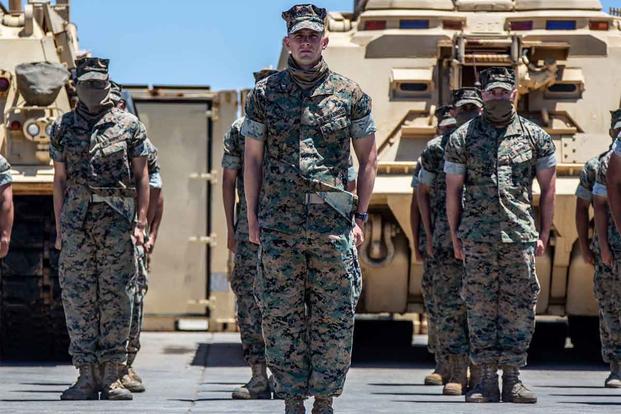Gary Anderson is a retired colonel who served as the director of Marine Corps Wargaming. He retired as the chief of staff of the Marine Corps Warfighting Lab.
The opinions expressed in this op-ed are those of the author and do not necessarily reflect the views of Military.com. If you would like to submit your own commentary, please send your article to opinions@military.com for consideration.
It is almost unheard of for retired Marine Corps general officers to criticize the policies of the sitting commandant, but three have recently done so. They joined Former Navy Secretary James Webb in criticizing Gen. David Berger's Force Design 2030 plan to revamp the Corps' warfighting strategy. Retired Gens. Charles Krulak (a former commandant himself), Jack Sheehan and Anthony Zinni penned an April 22 editorial in The Washington Post criticizing the new strategic vision. They appear to speak for a much larger group of retired general officers.
This is not a group of reactionary Colonel Blimps; they represent some of the most innovative minds that the Corps has produced in a half century.
Berger's vision, which he is actively pursuing, is to concentrate the Marine Corps' attention on China. He hopes to disrupt China's anti-navy, access denial strategy designed to foil U.S. power projection in that region. The concept calls for having Marine Corps units occupy islands in the South China Sea to counter China's attempt to dominate that body of water using long-range anti-ship and anti-air missiles.
The intent is to assist the Navy in disrupting the Chinese reconnaissance strike-complex that is designed to deny U.S. naval and Air Force access to the South China Sea. Once that is accomplished, U.S. and allied forces would be able to operate more freely. To buy a new range of capabilities, Berger is divesting the Marine Corps of many of its legacy combat systems. Most notably, he wants to mothball tanks. But also on the chopping block are helicopters and much of the Corps' tubed artillery, as well as some heavy engineering and logistics assets.
The four-star critics make some telling arguments against Berger's strategic direction. They point out that overspecialization against China degrades the Marine Corps' traditional mission as a force ready to rapidly deploy anywhere in the world, and that the discarded systems would be useful in surprise conflicts such as the one in Ukraine. They also point out that most of the new systems that Berger wants to buy already are prevalent in the Army, Navy and Air Force. They also observe that the new vision was not coordinated with the combatant commands, the Joint staff, or the nations laying claim to the target islands. There are also concerns regarding the feasibility of resupplying forces once engaged.
Focus on a specific potential enemy is not new to the Marine Corps. Marines developed their expertise in amphibious warfare in the years between the two world wars specifically to conduct operations in an expected conflict with Japan. Even then, there was internal debate over the wisdom of this approach.
At the time, the Marine Corps had been involved in small wars in the jungles of the Caribbean and Central America. The concept of being America's "force in readiness" was already deeply ingrained in the Corps. However, the difference between then and now is that the capabilities developed to conduct amphibious warfare were additive. The Corps divested itself of nothing to develop amphibious tractors, shore party organizations, and the use of carrier-based aviation as artillery early in landing operations before big guns could come ashore. Today, significant equipment has been retired without guarantees on investment.
Berger's defenders argue that the current Ukrainian conflict proves that tanks are obsolete. However, despite their success in tank killing, additional tanksm along with jet fighter-bombers, top the Ukrainian wish list for military aid as fighting ratchets up in the Eastern theater of that conflict.
Both the Trump and Biden administrations came to the realization that China has become a near-peer regional military threat, and the Marine Corps should be congratulated for giving serious thought to that fact. However, before further mothballing more hardware, the service should consider an approach that could realize the useful parts of Berger's vision while avoiding a nasty resource fight with the other services and maintaining the ability of the Marine Corps to fight in unexpected contingencies worldwide.
III Marine Amphibious Force on Okinawa is the organization tasked with carrying out Berger's strategy. An alternative would be to configure III MEF as a joint task force headquarters with augmentation from the other services to carry out early operations to disrupt China's anti-access strategy, with the Marine Corps' new littoral regiments as the nucleus for sub-joint task forces.
The other services would provide the long-range missiles and anti-air capabilities that the 2030 vision requires. III MEF has configured as a joint task force nucleus for real-world joint missions (mostly humanitarian) before and routinely participates in joint exercises in that capacity. This would ease friction with the other services and the combatant command outside of the Indo-Pacific theater.
The chairman of the Joint Chiefs of Staff would do well to sponsor a series of war games that would compare the joint and Marine Corps concepts. Single war games do not validate anything, but a series of four or five might give a good evaluation of the relative merits of both. The results might even challenge the strategic concept of defending the islands. Warfighting strategy is too important to be left to a single service.















